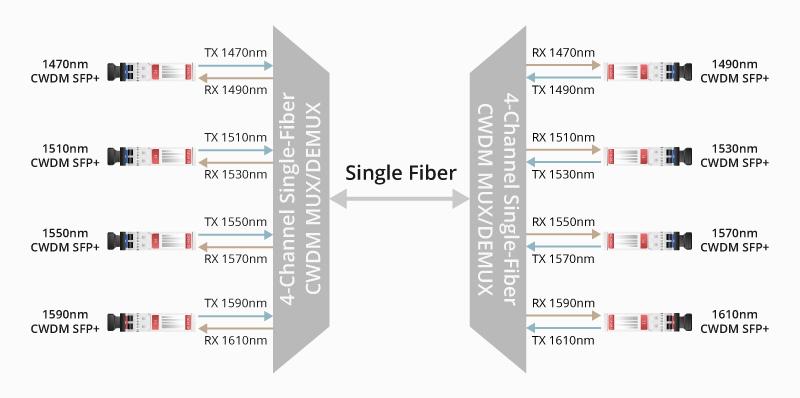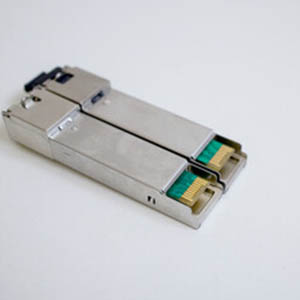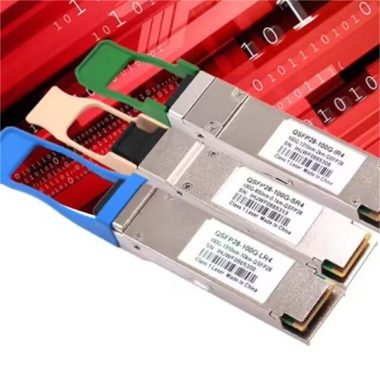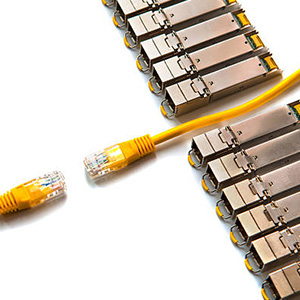Wavelength Division Multiplexing (WDM) transceiver modules, including CWDM and DWDM, use distinct wavelengths to multiplex multiple optical signals onto a single fiber. This approach not only boosts network bandwidth but also offers a cost-effective solution for long-haul applications such as Metropolitan Area Networks (MANs), Local Area Networks (LANs), and campus networks. This guide focuses on selecting 10G SFP+ CWDM and DWDM transceivers.
Optical Power Budget for 10G WDM Transceivers: A Crucial Consideration
The Optical Power Budget (OPB) indicates the available optical power necessary for successful signal transmission. As signals travel long distances, they undergo attenuation, leading to signal weakening. When choosing a 10G WDM module, it is essential to ensure that the transceiver’s optical power meets the specific transmission distance requirements.
Calculating the Optical Power Budget
Suppose you need to deploy a CWDM link that spans 35 km, includes two connectors (each with 0.6dB loss), and four fusion splicing points (each with 0.1dB loss). How do you verify if the OPB of the selected SFP+ CWDM transceiver is adequate? (Using the Cisco CWDM-SFP10G-1550 compatible CWDM SFP+ transceiver as an example.)
Standard OPB = TX power – RX power = (-1dBm) – (-16dBm) = 15dB
Total power loss = 2×0.6dB – 0.1×4dB = 1.6dB
Worst-case OPB = Standard OPB – Total optical power loss – 3dB (safety factor at 1550nm) = 10.4 dB
Worst-case transmission distance = (Worst-case OPB) / (Cable loss at 1550nm) = 10.4dB / 0.25dB/km = 41.6km
Conclusion: Considering all possible power losses, the Cisco CWDM-SFP10G-1550 compatible SFP+ CWDM module can support a transmission length of 41.6 km. Thus, this 10G CWDM module is suitable for the 35 km link example. However, remember that the optical power budget is based on theoretical calculations and serves as a reference. Attenuators should also be considered based on actual demands.
Confirming the Wavelength of 10G CWDM and DWDM Modules
CWDM transceivers support wavelengths ranging from 1270nm to 1610nm, while DWDM optics operate within the C-band, typically between 1528.77nm and 1563.86nm. The commonly used wavelength range for WDM systems is from 1470nm to 1550nm. Users should select the appropriate wavelength based on their network requirements. Note that switches not supporting wavelength division multiplexing (WDM) cannot directly connect with CWDM 10G SFP+ transceivers and DWDM 10G SFP+ modules but can use an OEO converter for wavelength conversion. To efficiently manage these wavelengths, users can refer to a CWDM or DWDM channel chart, which aids in identifying and organizing the specific wavelengths used in their network.
Selecting WDM SFP+ Transceivers Based on WDM MUX/DEMUX
Dual fiber and single fiber WDM MUX/DEMUX are widely used in the market, offering various configurations for data transmission. For instance, the dual fiber type uses two separate fibers to independently handle data transmission, while the single fiber CWDM MUX/DEMUX uses a single-strand fiber for both sending and receiving data simultaneously. Here are the different applications of WDM SFP+ transceivers in two scenarios.

Dual Fiber CWDM Configuration
SFP+ CWDM Modules on Dual Fiber CWDM MUX/DEMUX
In a dual-fiber CWDM MUX/DEMUX, two separate optical fibers are used for transmitting and receiving data to ensure that the channels do not interfere with each other. In this configuration, it is only necessary to ensure that the wavelengths at both ends are the same to achieve normal communication, without having to worry about the possibility of different wavelengths at both ends.
As shown in the diagram, users can seamlessly integrate the configuration by relying on consistent wavelengths at both ends. This enables them to easily select CWDM SFP+ modules with the appropriate wavelengths, ensuring a smooth connection to the CWDM MUX/DEMUX. This flexibility allows users to tailor their network setup to specific bandwidth requirements and infrastructure considerations, eliminating concerns about complex wavelength matching issues.
SFP+ CWDM Modules on Single Fiber CWDM MUX/DEMUX
In a single-fiber CWDM MUX/DEMUX, a single fiber is used to send and receive data simultaneously. To avoid signal interference, it is often chosen to use optical modules of adjacent wavelengths. For example, if you use a 1470 wavelength module at Site A, Site B can use a 1490 wavelength module. This configuration ensures the wavelength difference between adjacent channels, thus minimizing mutual interference between signals and maintaining communication stability.
Within the restricted reception range of optical modules at both ends, modules with adjacent wavelengths can establish normal connections. As shown in the figure below, take a pair of 4-channel single-fiber CWDM MUX/DEMUX as an example. The first CWDM MUX port at Site A uses 1470nm wavelength to transmit data and needs to be connected to a 1470nm TX SFP+ CWDM module. The receiver should align its wavelength with that of the CWDM module to receive the corresponding optical signal, for instance, at 1490nm. Ensuring the correct pairing of transmitter and receiver wavelengths is critical to ensure consistent signal transmission and reception.
Notice: Building on the aforementioned principles, SFP+ DWDM modules adhere to similar principles when coupled with DWDM MUX/DEMUX. Whether in a dual-fiber or single-fiber DWDM MUX/DEMUX configuration, the matching strategy remains consistent. For instance, in a single-fiber DWDM MUX/DEMUX setup, if the first port at Site A transmits data at 1550nm, a DWDM SFP+ module with a 1550nm TX should be selected for that specific connection. The receiver needs to match the wavelength of the DWDM module to receive the corresponding optical signal. There must be paired TX and RX wavelengths on the same port to ensure consistent data transmission.

Single Fiber CWDM Configuration
Guaranteeing Compatibility Between Devices and New Modules
A myriad of network equipment brands, such as Cisco, Juniper, Arista, have emerged in the market. Ensuring new 10G WDM optical modules are compatible with devices from various brands is crucial. Note that original brand optical modules are often much pricier. Therefore, it’s advisable to buy from reputable third-party suppliers. Third-party optical modules offer cost advantages and strengths, including flexible customization options and extensive compatibility, while maintaining excellent performance and quality. Opting for a highly reputable third-party supplier provides cost-effective, high-performance solutions, along with premium after-sales service and technical support.
Considering Special Network Requirements
10G BiDi and tunable modules are special types of 10G CWDM and DWDM optical transceivers. If users need to increase their network capacity and require an easier cabling system, BiDi SFP+ fiber transceivers will suit their demands since the modules send and receive data over one-strand fiber. SFP+ tunable fiber transceivers are suitable solutions for users who need to tune the wavelength of the modules based on their actual demands.
CWDM and DWDM SFP+ Transceivers: Q&A
Q: Is it possible to convert conventional wavelengths, like 850nm, into DWDM or CWDM wavelengths?
A: If you require the conversion of wavelengths into CWDM or DWDM wavelengths, you can utilize an Optical-Electrical-Optical (OEO) converter to achieve this. The OEO converter facilitates wavelength conversion through O-E-O transformation technology.
Q: How to choose between 100GHz and 50GHz in DWDM channel spacing?
A: When comparing 50GHz and 100GHz transceivers, the telecom industry commonly favors the 100GHz C-Band transceiver. With a channel spacing of 0.8nm around 1550nm, this configuration is widely adopted. Channels are designated by colors or wavelengths, and channels 17 to 61 are frequently employed.
Q: How to select suitable fiber cables for CWDM and DWDM SFP+ transceivers?
A: The optical cable can be divided into two types: single-mode fiber optic cable and multimode fiber optic cable. The former is typically used for long-distance transmission, while the latter is suitable for short-distance transmission. To support CWDM and DWDM SFP+ transceiver links with distances of up to 80 kilometers, we opt for single-mode fiber optic cables with LC connectors.
Q: Are there differences in transmission quality between CWDM and DWDM wavelengths? Which wavelengths provide better performance?
A: Yes, different wavelengths can affect transmission quality. Generally, 1470nm and 1550nm are the most commonly used wavelengths, with 1550nm being more popular. This is because 1550nm experiences less attenuation, providing better transmission quality for long










